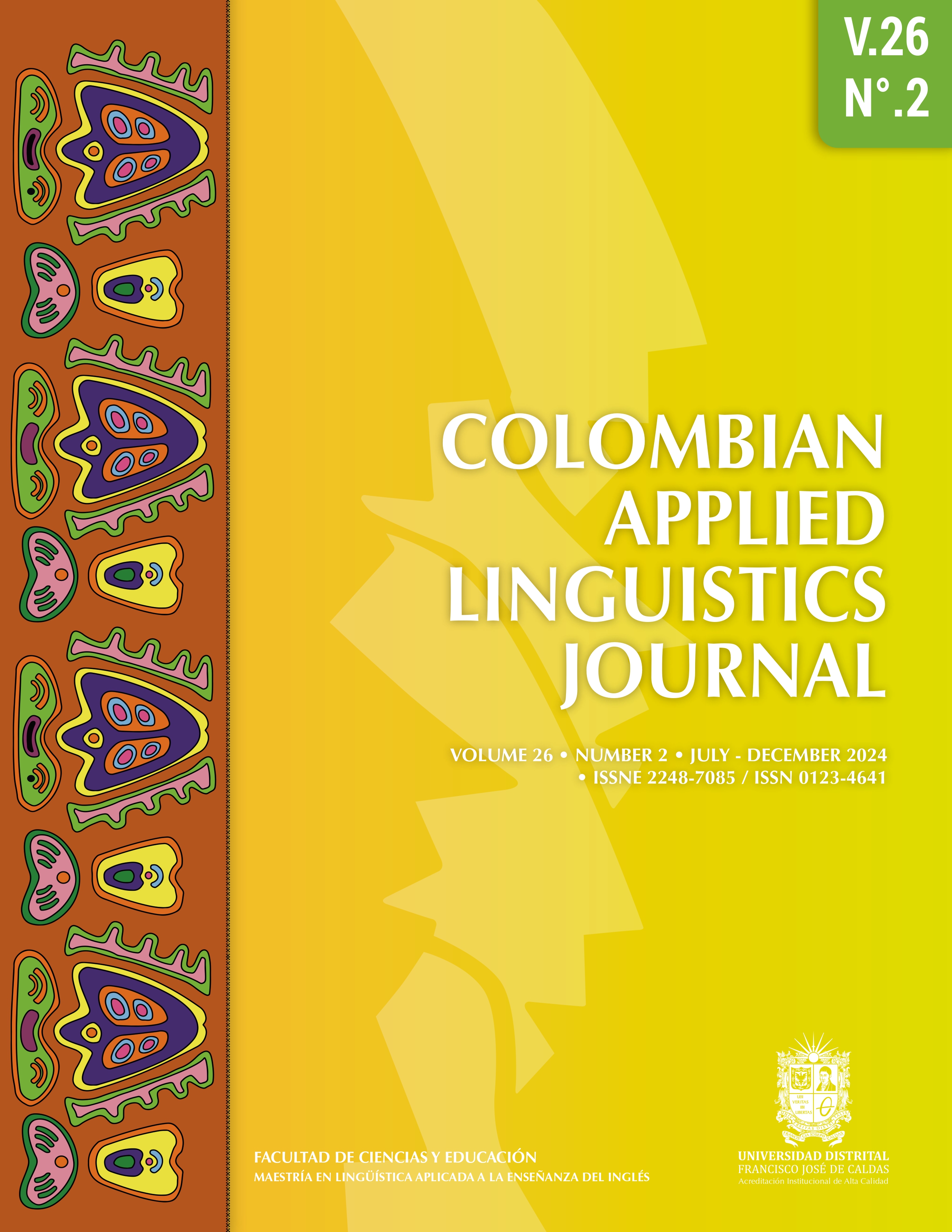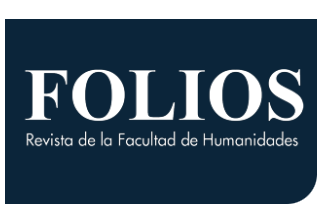DOI:
https://doi.org/10.14483/22487085.20823Published:
2024-10-23Issue:
Vol. 26 No. 2 (2024): CALJ : july-decemberSection:
Research ArticlesHabilidad metalingüística en inglés como L2 en estudiantes universitarios mexicanos
Metalinguistic Ability in English as a L2 among Mexican University Students
Keywords:
inglés L2, juicios de gramaticalidad, habilidad metalingüística (es).Keywords:
metalinguistic ability, English as L2, gramaticality judgments (en).Downloads
Abstract (es)
El problema con las Pruebas de Juicio de Gramaticalidad en el campo de la adquisición de L2 es que los sujetos hacen juicios intuitivos sobre la precisión de la forma y gramática de oraciones individuales y descontextualizadas en L2. Este artículo replica un estudio empírico utilizando una Prueba de Juicio de Gramaticalidad no cronometrada en el software PychoPy, en el que se evalúa la habilidad metalingüística de 13 estudiantes universitarios para distinguir entre construcciones gramaticalmente correctas e incorrectas en L2. Los participantes emitieron juicios sobre 68 estructuras consideradas universalmente difíciles de adquirir entre los aprendientes (Ellis, 2005). Los resultados variaron según la habilidad metalingüística de los participantes, el tipo de error en las oraciones (morfológico o sintáctico) y la dificultad para adquirir estructuras complejas. El análisis la base de datos reveló que la emisión de juicios gramaticales no depende del nivel de competencia lingüística en inglés como L2, sino de la capacidad para reflexionar sobre las formas y significados del lenguaje. Se concluye que cuando los participantes procesan oraciones individuales y descontextualizadas en L2, detectan más fácilmente errores morfológicos que sintácticos y que la adquisición de la lengua no es lineal.
Abstract (en)
The problem with grammaticality judgment tests in the field of L2 acquisition lies in the fact that language users make intuitive judgments about the accuracy of the form and grammar of individual, decontextualized L2 sentences. This article replicates an empirical study using an untimed grammaticality judgment test conducted through PsychoPy software, assessing the metalinguistic abilities of 13 university students in distinguishing between grammatically correct and incorrect L2 constructions. Participants evaluated 68 structures considered universally difficult for L2 learners to acquire (Ellis, 2005). Results varied based on participants’ metalinguistic abilities, the type of error (morphological or syntactic), and the complexity of structures. Analysis revealed that grammatical judgments depend less on participants' overall linguistic competence in English as an L2 and more on their ability to reflect on language forms and meanings. The study concludes that participants more easily detect morphological than syntactic errors when processing individual, decontextualized L2 sentences, highlighting the non-linear nature of language acquisition.
References
Andonova, E., Janyan, A., Kostadinova, T., Raycheva, M., & Stoyanova, K. (2005). Grammaticality Judgment of Article Use in Aphasic Speakers of Bulgarian. Proceedings of the Annual Meeting of the Cognitive Science Society, 27. Retrieved from https://escholarship.org/uc/item/9vb654f9
Asiyaban, A. R., Yamini, M., Bagheri, M. S., & Yarmohammadi, L. (2019). A Cross-Sectional Investigation into the Implicit and Explicit Knowledge of the Article System in Iranian Learners' Approximative System. International Journal of Instruction, 12(4), 479-494.
Bowles, M. (2011). Measuring implicit and explicit linguistic knowledge: What can heritage language learners contribute? Studies in Second Language Acquisition, 33, 247-271.
Brown, J. M., Fanselow, G., Hall, R., & Kliegl, R. (2021). Middle ratings rise regardless of grammatical construction: Testing syntactic variability in a repeated exposure paradigm. Plos one, 16(5), e0251280.
Çandarlı, D. (2018). Changes in L2 writers’ self-reported metalinguistic knowledge of lexical phrases over one academic year. The Language Learning Journal, 48(6), 768-784. https://doi.org/10.1080/09571736.2018.1520914
Council of Europe (2001). Common European Framework of Reference for Languages: Learning, Teaching, Assessment. Cambridge: Cambridge University Press.
Culbertson, J. & Gros, S. (2009). Are Linguists Better Subjects? British J. Phil. Sci., 60, 721–736.
De Keyser, R. (1998). Beyond focus on form: Cognitive perspectives on learning and practicing second language grammar. In C. Doughty, & J. Williams (Eds.), Focus on form in classroom second language acquisition (pp. 42-63). Cambridge: Cambridge University Press.
De Keyser, R. (2020). Skill acquisition theory. In Theories in second language acquisition (pp. 94–112). Routledge.
Dubravac, V. (2022). Explicit and implicit knowledge of English tenses in primary school EFL learners in Bosnia and Herzegovina. Strani jezici: časopis za primijenjenu lingvistiku, 51(1), 77-104.
El Euch, S., & Huot, A. (2015). Strategies to develop metalinguistic awareness in adult learners. WEFLA 2015, International Conference on Foreign Languages, Communication and Culture, Holguin (Cuba), April 27-29. https://doi.org/10.13140/RG.2.1.3207.9529
Ellis, R. (1998) Teaching and research: Options in grammar teaching. TESOL Quarterly, 32, 39–60.
Ellis, R. (2005). Measuring implicit and explicit knowledge of a second language. A psychometric study. Studies in Second Language Acquisition, 27, 141-172.
Ellis, R. (2006). Current issues in the teaching of grammar: An SLA perspective. TESL Quarterly, 40(1), 83-107. https://doi.org/10.2307/40264512
Ellis, R. (2008). Investigating grammatical difficulty in second language learning: Implications for second language acquisition research and language testing. International journal of applied linguistics, 18(1), 4-22.
Ellis, R., & Roever, C. (2021). The measurement of implicit and explicit knowledge. The Language Learning Journal, 49(2), 160-175.
Ellis, R., Loewen, S., Elder, C., Erlam, R., Philp, J., & Reinders, H. (2009). Implicit and explicit knowledge in a second language learning, testing and teaching. Clevedon: Multilingual Matters.
Fazlali, B., & Shahini, A. (2019). The Effect of Input Enhancement and Consciousness-Raising Techniques on the Acquisition of Lexical and Grammatical Collocation of Iranian EFL Learners. TESL-EJ, 24(2).
Gavaldà, N., & Queralt, S. (2020). Determining the Level of a Language Test with English Profile. Atlantis, 42(2), 1-21.
Godfroid, A. (2022). Implicit and explicit learning and knowledge. In Research questions in language education and applied linguistics: A reference guide (pp. 823-829). Cham: Springer International Publishing.
Godfroid, A., Loewen, S., Jung, S., Park, J. H., Gass, S., & Ellis, R. (2015). Timed and untimed grammaticality judgments measure distinct types of knowledge: Evidence from eye-movement patterns. Studies in Second Language Acquisition, 37(2), 269–297.
Gutiérrez, X. (2013). The construct validity of grammaticality judgment tests as measures of implicit and explicit knowledge. Studies in Second Language Acquisition, 35(3), 423–449.
Hawkins, R. (2001). The theoretical significance of Universal Grammar in second language acquisition. Second Language Research, 17(4), 345-367.
Hsia, S. (1991). Grammaticality judgments, paraphrase and reading comprehension: Evidence from European, Latin American, Japanese and Korean ESL learners. Hong Kong Journals Online, 3, 81-95.
Isbell, D. R., & Rogers, J. (2020). Measuring implicit and explicit learning and knowledge. In The Routledge handbook of second language acquisition and language testing (pp. 305-315). Routledge.
Kim, K. M., & Godfroid, A. (2019). Should we listen or read? Modality effects in implicit and explicit knowledge. The Modern Language Journal, 103(3), 648-664.
Krashen, S. (1982). Principles and practice in second language acquisition. Pergamon Press.
Loewen, S. (2009). Grammaticality judgment tests and the measurement of implicit and explicit L2 knowledge. In R. Ellis, S. Loewen, C. Elder, R. Erlam, J. Philp, & H. Reinders (Eds.), Implicit and explicit knowledge in second language learning, testing and teaching (pp. 94–112). Multilingual Matters.
Mandell, P. B. (1999). On the reliability of grammaticality judgement tests in second language acquisition research. Second Language Research, 15(1), 73-99.
Masny, D., y D’Anglejan, A. (1985). Language, cognition, and second language grammaticality judgments. Journal of Psycholinguistic Research,14(2), 175-197.
Meyerhoff, H. S., & Papenmeier, F. (2020). Individual differences in visual attention: A short, reliable, open-source, and multilingual test of multiple object tracking in PsychoPy. Behavior Research Methods, 52, 2556-2566.
Murniati, M. (2022). Investigating the Roles of Implicit and Explicit Knowledge in the Production of Grammatical Errors. Journal of English Language and Culture, 11(2).
Rimmer, W. (2006). Grammaticality judgment tests: trial by error. Journal of Language and Linguistics, 5(2), 246–261. Retrieved from http://www.jllonline.co.uk/journal/5_2/LING 6.pdf
Sandor, K. (2015). Implicit Knowledge, Explicit Knowledge and Their Relation to General Language Proficiency, In: The Publications of the MultiScience ‒ XXIX. microCAD International Multidisciplinary Scientific Conference (pp. 1-14). Miskolc: Miskolci Egyetem.
Satori, M. (2023). The role of automatised and non-automatised explicit knowledge in general L2 proficiency. The Language Learning Journal, 52(4), 454–467. https://doi.org/10.1080/09571736.2023.2207585
Smith, M. S. (2021). The cognitive status of metalinguistic knowledge in speakers of one or more languages. Bilingualism: Language and cognition, 24(1), 185-196.
Syahid, A. H., & Nurdianto, T. (2022). Brain Lateralization and Strategies to Improve Metalinguistic Ability in Arabic Language Acquisition. ALSUNIYAT: Jurnal Penelitian Bahasa, Sastra, dan Budaya Arab, 5(2), 185-203.
Tan, B. H., & Nor Izzati, M. N. (2015). Grammaticality judgement test: Do item formats affect test performance? Pertanika Journal of Social Sciences and Humanities, 23(December), 119–130.
Teira, C., & Polo, N. (2021). Digitalización y recursos para la investigación en Lingüística: http://dx. doi. org/10.31810/RSEL. 51.1. 9. Revista Española de Lingüística, 51(1), 157-176.
Tremblay, A. (2005). Theoretical and methodological perspectives on the use of grammaticality judgment tasks in linguistic theory. Second Language Studies, 24(1), 129-167.
Tuttle, B. E., & Munalim, L. O. (2022). Millennial students’ metalinguistic knowledge on headlines Using Grammaticality Judgment Test. Studies in English Language and Education, 9(3), 1093-1111.
Vafaee, P., Suzuki, Y., & Kachisnke, I. (2017). Validating grammaticality judgment tests: Evidence from two new psycholinguistic measures. Studies in Second Language Acquisition, 39(1), 59-95.
Ward, D. F., & Lo, Y. Y. (2023). Incidental development of implicit and explicit grammar knowledge from reading: The case of lower-intermediate learners of English. System, 116, 103094.
Yamamoto, S. (2023). Measuring Implicit and Explicit Knowledge in Second Language Learning: Focusing on the Three Design Features of the Grammaticality Judgement Test. TELES Journal, 43, 112-127.
How to Cite
APA
ACM
ACS
ABNT
Chicago
Harvard
IEEE
MLA
Turabian
Vancouver
Download Citation
Metrics
License
Copyright (c) 2024 Selene Maya-Ruiz

This work is licensed under a Creative Commons Attribution-NonCommercial-NoDerivatives 4.0 International License.
This work is licensed under a Creative Commons Attribution-NonCommercial-NoDerivatives 4.0 International License.
Attribution — You must give appropriate credit, provide a link to the license, and indicate if changes were made. You may do so in any reasonable manner, but not in any way that suggests the licensor endorses you or your use.
NonCommercial — You may not use the material for commercial purposes.
NoDerivatives — If you remix, transform, or build upon the material, you may not distribute the modified material.
The journal allow the author(s) to hold the copyright without restrictions. Also, The Colombian Apllied Linguistics Journal will allow the author(s) to retain publishing rights without restrictions.









